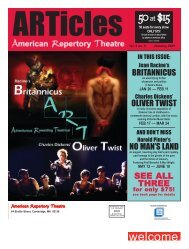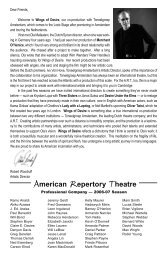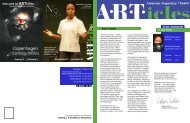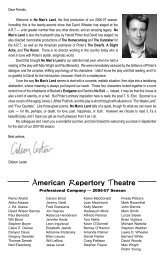CARMEN THE KEENING - American Repertory Theater
CARMEN THE KEENING - American Repertory Theater
CARMEN THE KEENING - American Repertory Theater
Create successful ePaper yourself
Turn your PDF publications into a flip-book with our unique Google optimized e-Paper software.
What’s Happening<br />
at Zero Arrow Theatre<br />
W<br />
The Crying of the Plañidera<br />
Ryan McKittrick traces the development of The Keening<br />
hen the director Nicolás Montero and<br />
the leading Colombian actress Vicky<br />
Hernández began developing a new,<br />
one-woman piece, they spent the first week of<br />
rehearsal working on a series of improvisations. An<br />
anthropologist who acted with the Teatro Libre de<br />
Bogotá before training at the Central School of<br />
Speech and Drama in London, Montero guided,<br />
observed, and responded as Hernández explored<br />
a range of painful emotions and memories. After<br />
hours of exhausting improvisations that produced<br />
tears and screams, the actress sat down and said,<br />
“My heart is wide open.” Even before the two<br />
artists had a text, they had a title for their project:<br />
Con El Corazón<br />
Abierto (With a<br />
Heart Wide Open).<br />
Montero and<br />
Hernández quickly<br />
found themselves<br />
in need of a writer<br />
who could create a<br />
character out of<br />
these initial exercises,<br />
and transform<br />
them into a<br />
dramatic event. So<br />
they reunited with<br />
their friend Humberto Dorado, a screenwriter and<br />
actor who had performed in Montero’s production<br />
of David Mamet’s Oleanna at the National Theatre.<br />
Dorado had written roles in his screenplays specifically<br />
for Hernández, and he was immediately interested<br />
in building a play around an actress he<br />
describes as “a force of nature — the kind of performer<br />
who makes you think you need to put up<br />
bars between the stage and the audience. She’s<br />
like a tiger, but with a profound tenderness.”<br />
Inspired in part by the dearth of new<br />
Colombian plays, the three artists resolved to create<br />
a piece that grappled with the reality of their<br />
contemporary society. “We decided to make a<br />
piece about something immediate, something that<br />
was part of our daily lives,” explains Dorado. “We<br />
hear about the horrors that surround us every day,<br />
but we’re numb to them.” The project, which the<br />
writer began to envision as a modern Colombian<br />
tragedy, would recover the brutality and horror of<br />
the atrocities that have become quotidian in the<br />
country’s decades-old civil conflict.<br />
As Dorado observed rehearsals, a character<br />
began to take shape. Years earlier, the playwright<br />
had met a plañidera (a professional mourner or<br />
keener) in northern Colombia who shared her life<br />
story with him. Drawing from that woman’s experiences,<br />
from stories he had heard over the years,<br />
and from Hernández’s improvisations, the playwright<br />
started to develop his narrator. He imagined<br />
an anonymous plañidera whose suffering would<br />
recall the experiences of so many rural Colombian<br />
women and whose dirges would lament the pain of<br />
the entire nation.<br />
In a country where calamity has become routine,<br />
it wasn’t long before a gruesome article fell into<br />
the playwright’s hands and gave him new raw<br />
material for a tragedy. While the artists were continuing<br />
to develop the play, Washington Post correspondent<br />
Scott Wilson sent Dorado his investigative<br />
report about the massacre at Chengue, a small<br />
village known<br />
for its avocado<br />
or-chards.<br />
Situated in<br />
northern Colombia<br />
near<br />
major transportation<br />
routes leading<br />
to the<br />
Caribbean<br />
coast, the<br />
region around<br />
Chengue has<br />
been caught in the crossfire of guerrilla, military,<br />
and paramilitary forces for years. On January 17,<br />
2001, months after Chengue residents had repeatedly<br />
pleaded for protection from the president and<br />
the regional military command, paramilitary forces<br />
cut off the village’s electricity, marched into the<br />
town, and slaughtered twenty-six of the townsmen<br />
using stones and a sledgehammer. As they left, the<br />
forces set fire to the town. The paramilitary AUC<br />
(Autodefensas Unidas de Colombia or United Self-<br />
Defense Forces of Colombia) carried out the attack<br />
to punish Chengue for allegedly giving supplies to<br />
the leftist FARC (Fuerzas Armadas<br />
Revolucionarias de Colombia or Revolutionary<br />
Armed Forces of Colombia). Two days after the<br />
massacre, Wilson interviewed the remaining inhabitants<br />
of the town. They told him that they believed<br />
the Colombian military, which is stationed in the<br />
region to combat both guerrilla and paramilitary<br />
forces, had helped the AUC carry out the attack.<br />
Dorado incorporated Wilson’s report in the<br />
script, changing the locale but preserving the<br />
names of the victims. And as the overall structure<br />
of the play emerged, so did the protagonist’s overarching<br />
objective. The plañidera, Dorado decided,<br />
was not only sharing her life experiences with the<br />
audience; she was also in the process of making a<br />
Vicky Hernández, Nicolás Montero, Humberto Dorado.<br />
decision about how to confront the violence tearing<br />
apart her country.<br />
As Dorado finished the script, the internationally<br />
renowned Mexican scenic designer Alejandro<br />
Luna joined the artistic team. Luna created a symmetrical,<br />
elevated playing space for the production<br />
that could serve as a hospital, a morgue, or a funeral<br />
home — all spaces the plañidera revisits over the<br />
course of the play. A large mirror was positioned<br />
upstage, and fluorescent lights extended out from<br />
the stage over the audience’s heads. “I wanted to<br />
create a kind of amplified microscopic exhibition,”<br />
explains Luna, “as if the set were a slide on a<br />
microscope. I wanted it to be a kind of resonator for<br />
the emotions of the piece.”<br />
Luna also made the four elements — earth,<br />
water, fire, and air — an integral part of the design.<br />
Incense and smoke made the air visible; purifying<br />
water flowed out of a tap; candles brought ritualistic<br />
fire to the stage; and black volcanic rocks surrounded<br />
the central playing space, referencing the<br />
violence that has transformed a once-lush countryside<br />
into a charred, carbonized wasteland.<br />
When the play opened in Bogotá after almost<br />
two years of development, the public response was<br />
overwhelming. Even the ex-president, Ernesto<br />
Samper Pizano, and the then mayor of Bogotá,<br />
Antanas Mokus, came to see the production. “The<br />
piece was a huge success,”<br />
remembers<br />
Luna. “At the end of the<br />
performance, everyone<br />
kept saying ‘thank you,<br />
thank you.’ Most of the<br />
families in Colombia<br />
can tell you that they<br />
have a nephew who<br />
has been killed. Or that<br />
they don’t know if one of<br />
their relatives is alive or<br />
in jail. They live with<br />
this all the time. But you<br />
never see it in the<br />
Colombian theatre.”<br />
“It was a purely<br />
theatrical event,” Vicky Hernández in a scene from<br />
Dorado recalls. “People Con El Corazón Abierto in Bogotá.<br />
hear about these<br />
tragedies every day — about the massacres, the<br />
bloody repression, the misery, the displaced<br />
refugees, the violence. Everyone knows what’s<br />
going on. But when you see it in the theatre, the<br />
experience surpasses other means of communication.”<br />
For the director, the suffering endured by the<br />
victims of rural massacres could never be fully represented<br />
on the stage, but the production had<br />
brought them closer to understanding their experience.<br />
“I made this piece in order to understand<br />
reality,” Montero reflects, “not to interpret it. Reality<br />
in Colombia is so baroque, so complicated. When<br />
you turn on the TV and hear about the massacres,<br />
and the way they are performed — not just shooting<br />
people but virtually destroying their bodies —<br />
you understand that you’re dealing with something<br />
very complex. I don’t think there’s a language that<br />
can represent their pain. A play, painting, music or<br />
any artistic language can’t really describe the feelings<br />
we’re dealing with. But the production brought<br />
us closer to the voices of these victims.”<br />
In 2004, A.R.T. Artistic Director Robert<br />
Woodruff saw Con El Corazón Abierto at the<br />
biannual International Theatre Festival of Bogotá.<br />
Struck by the intensity and immediacy of the production,<br />
he invited Montero to direct the play at<br />
Zero Arrow Theatre, the A.R.T.’s new second stage<br />
in Harvard Square. Using a translation by Joe<br />
Broderick retitled The Keening, Montero will<br />
restage the piece this fall with the actress Marissa<br />
Chibas. Luna will redesign the set, adjusting his<br />
original model slightly for the Zero Arrow Theatre.<br />
Montero didn’t need time to consider<br />
Woodruff’s offer to stage The<br />
Keening at the A.R.T. For him,<br />
directing the play is an act of conscience<br />
and a social obligation.<br />
“As a society, we need to know<br />
who the victims of this conflict are,”<br />
he explains. “These are real<br />
names that will travel all the way<br />
from Colombia to Cambridge, and<br />
be heard on the other end of the<br />
world. It’s a sort of exorcism to<br />
say these names aloud to audiences<br />
abroad. We have to try to<br />
find language that will give voices<br />
to these victims. As a Colombian<br />
director and actor, I can’t turn my<br />
face away from them. For me,<br />
theatre is about necessity. You<br />
don’t do it because you want to —<br />
you do it because you have to.”<br />
Ryan McKittrick is the<br />
A.R.T.’s Associate Dramaturg.<br />
ARTicles<br />
5




![Wild Swans Program [pdf] - American Repertory Theater](https://img.yumpu.com/49339866/1/167x260/wild-swans-program-pdf-american-repertory-theater.jpg?quality=85)

![Press Release: Trojan Barbie [pdf] - American Repertory Theater](https://img.yumpu.com/47571290/1/190x245/press-release-trojan-barbie-pdf-american-repertory-theater.jpg?quality=85)
![Articles issue as 4_2 [pdf] - American Repertory Theater](https://img.yumpu.com/45053160/1/190x249/articles-issue-as-4-2-pdf-american-repertory-theater.jpg?quality=85)

![Three Pianos Program [pdf] - American Repertory Theater](https://img.yumpu.com/41616353/1/167x260/three-pianos-program-pdf-american-repertory-theater.jpg?quality=85)
![Three Sisters [pdf] - American Repertory Theater](https://img.yumpu.com/40969361/1/190x245/three-sisters-pdf-american-repertory-theater.jpg?quality=85)


![Program: Sleep No More [pdf] - American Repertory Theater](https://img.yumpu.com/24629394/1/167x260/program-sleep-no-more-pdf-american-repertory-theater.jpg?quality=85)
![Porgy and Bess Program [pdf] - American Repertory Theater](https://img.yumpu.com/24481101/1/167x260/porgy-and-bess-program-pdf-american-repertory-theater.jpg?quality=85)
![Program: Carmen [pdf] - American Repertory Theater](https://img.yumpu.com/24481072/1/190x245/program-carmen-pdf-american-repertory-theater.jpg?quality=85)
